February 2014
Our winter
feels like a continuance of our fall, very mild temperatures and quite wet. Here
in the western part of the Netherlands we haven't seen any snow yet and March
has just begun. In the garden buts and new leaves are sprouting from some trees and
plants and we've already been able to sit outside for a few hours, with the mild
warmth of the sun on our faces. It was only one afternoon, but if we're not
mistaking, spring is already in the air and we have completely skipped winter
this year.
March will bring us the first collectors meeting. This year we hope not to
oversleep and actually attend Alex Claes' Spring Bourse in Lokeren, Belgium. It
will be followed by a general collectors fair in the Netherlands and we're
looking forward to see the Belgian collectors and Dutch sellers again during
these events. And of course we hope to find some nice decks along the way too! But
let's not get ahead of ourselves and look back at February first.........
|
A short month, but not short of new decks
for our collection. No collectors meetings and only a few flea markets
in our region, but once again the internet proved to be a good source. |
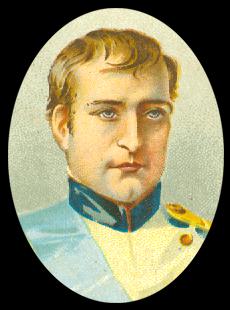 |
|
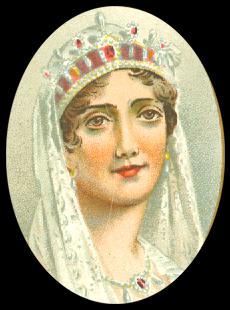
|
|
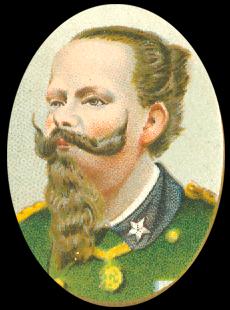
|
|
The Dutch
auction site brought us an unexpected, old version of the special Fortuna
deck for the SMN shipping line which we could add to our collection of
the Speelkaartenfabriek Nederland and it brought us some nice decks to
trade too. But Ebay was the main supplier for our interesting shortlist
for this month. Worth mentioning are an antique deck |
with an
early version of the Dutch pattern and German scenic aces by Leonard
Biermans from Turnhout (Belgium), a vintage Swedish deck by Oberg from
the 1950's and a 2011 Bicycle deck about Venice and its carnival with
beautiful designed courts. But this month we went for these fine
portraits. |
The deck was
printed in fine chromolithography by Goodall and Son Ltd from London. It's the
lesser seen of three British decks that were published in the last decade of the
19th century by Charles (Chas) Goodall and Son. We already have the Victorian deck
(1897) and the Historic deck (1893). The deck isn't described in the Cary
collection, but according to the Fournier catalogue this third deck (British
Isles # 350, page 227) was published in 1900. It's described as: "Deck
commemorating the advent of the XX CENTURY. The monarchs, their consorts and
foreign ministers of England, France, Russia and Germany are shown on the courts
cards. Aces printed with flags and the reverse depicts portraits of Queen
Victoria, William IV, George III and George IV".
However, this description contains a major fault and an unjust simplification.
The monarch, consort and foreign minister of England are not to be found on the
court cards, nor its flag on the aces. Instead Italy is represented -as fourth
country- on the Hearts. On the Jacks only Talleyrand has functioned as a foreign
minister for a while. The others were either chancellor or prime minister or
general in their function under the presented king or emperor.
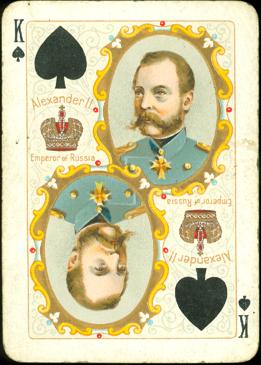
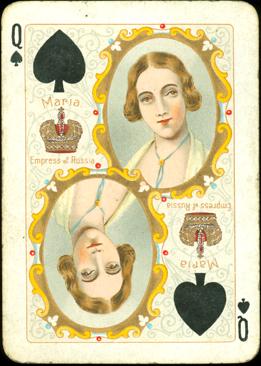
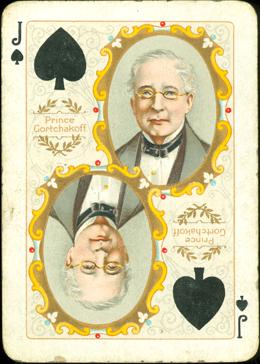
The Spades suit is
dedicated to Russia and the reign of Tsar Alexander II as emperor there from 1855 until
1881 (when he was assassinated). Alexander II was the most successful Russian
reformer since Peter the Great. He was married to Maria Alexandrovna,
the Russian name of the originally German Marie von Hesse. Prince Alexander
Mikhailovich Gorchakov served as chancellor of the Russian Empire under
Alexander II.
Victor Emmanuel II
married his cousin Adelaide of Austria in 1842. He assumed the title of King of
Italy in 1861 as first king of a united Italy since the 6th century. This didn't
come easy. Victor Emmanuel II had to fight in 3 wars for Italian independence.
He was greatly assisted by Guiseppe Garibaldi, an Italian general who conquered
the southern part of Italy, while Victor Emmanuel was fighting in the North of
Italy. Victor Emmanuel II died in 1878.
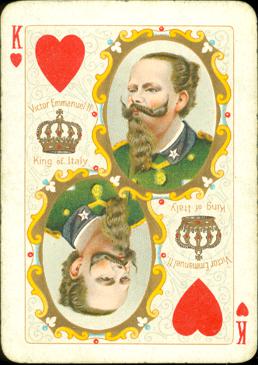
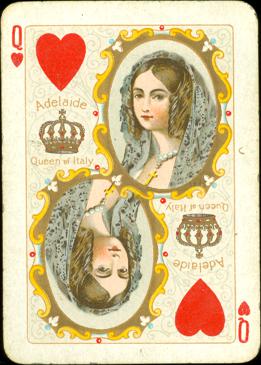
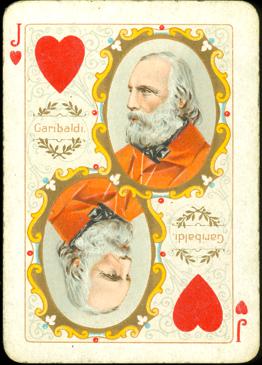
On the Ace
of Spades the Naval Jack of Russia with the blue St. Andrew's Cross (used
between 1701 and 1924) and the Imperial banner are depicted.
The Ace of Hearts shows the flag of the Kingdom of Sardinia, the Italian
tricolore with the coat of arms of Savoy in the middle, and the flag of the
House of Savoy
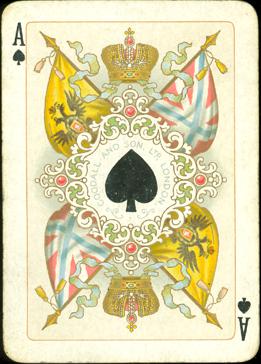
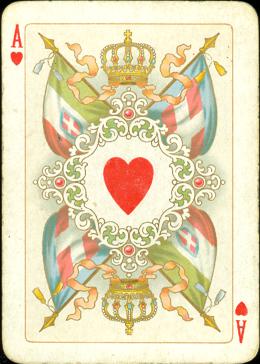
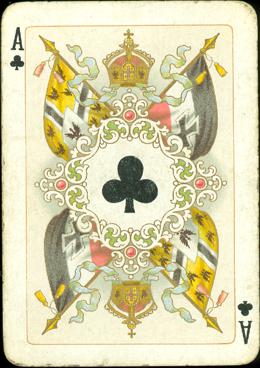
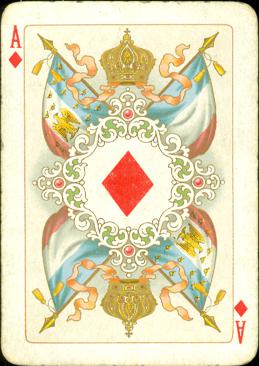
The Ace Clubs
shows the flag of the House of Hohenzollern and the marine jack of the North
German Confederation, later also used as the Marine jack of the German Empire.
The Ace of Diamonds has two French flags, of which one is decorated with the
Imperial Eagle (flag eagle or "aigle de drapeau"), introduced by
Napoleon I.
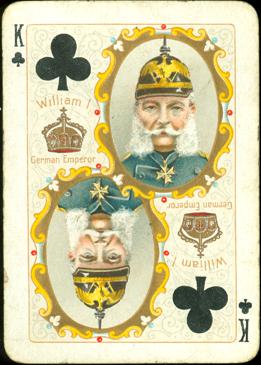
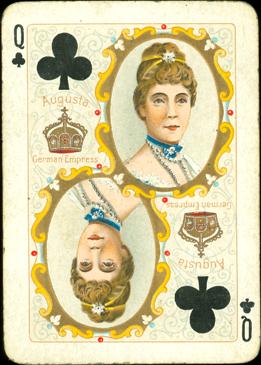
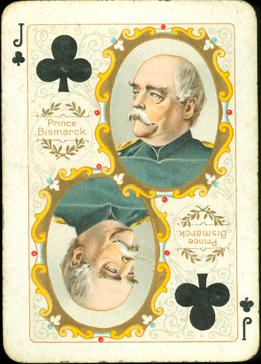
William (Wilhelm)
of Prussia had a successful career in the Prussian army, when he succeeded his elder
brother as King of Prussia in 1861. He had married princess Augusta of
Saxe-Weimar-Eisenach in 1829. Together with his prime minister Otto von
Bismarck, but under William's leadership Prussia achieved the unification of
Germany and established the German Empire in 1871. As William I he was German Emperor from
1871 until his death in 1888.
Napoleon I was
emperor of France from 1804 until 1814. He was married to Joséphine de
Beauharnais, who died of pneumonia on May 29, 1814, four days after catching cold during a walk with Tsar Alexander
in the rose gardens of her Chateau Malmaison. The reign of Napoleon I came to an
end at Waterloo in 1815. Talleyrand was Napoleon's chief diplomatic aide.
Although Napoleon trusted him, he undermined his emperor's plans for war against
Russia by secretly dealing with Tsar Alexander.
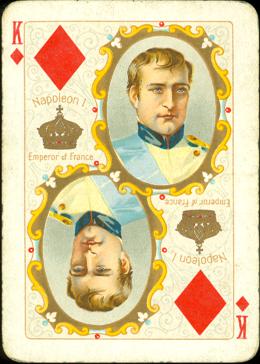
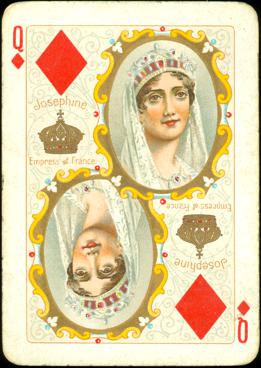
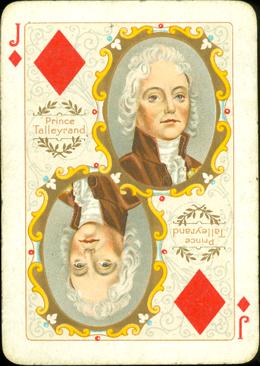
The design of the
courts is quite different from that of the other two decks. The Victorian deck
is single imaged and the Historical deck has a double image, but in the regular
way. This design is a double image, but the images are set in a medallion like
rim. One of the medallions overlaps the other, so it's not an exact double image
design. There are large indices, but the Kings and Queens are also indicated as
royal by the crown next to the medallion, with their name above and title
underneath. The Jacks show their names over a laurel wreath, a symbol of honor
and victory.
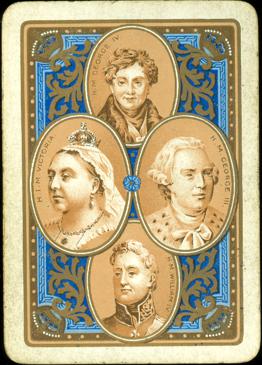 |
The back
design shows four British rulers: George III, who was king from 1760 to
1820 and George IV, who succeeded him until his death in 1830. William
IV had a short reign as king until his death in 1837 and he was
succeeded by Victoria, who reigned as queen until 1901. Together they
represent the British monarchy in the 19th century.
"Commemorating
the advent of the XX century" is one way of looking at this deck,
but I would prefer to see the deck as a remembrance of the 19th century,
a looking back at those who have created empires and unified countries
during that century. |
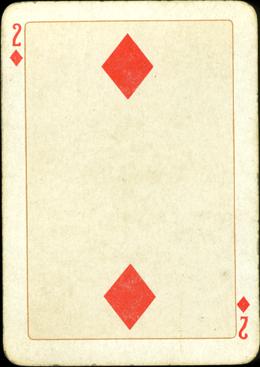
|
|
Our deck came without a box or wrapper. |
BACK TO PRESENT MONTH




















